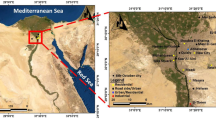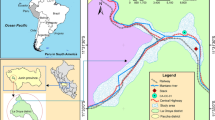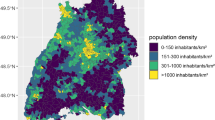Abstract
This article presents and discusses SO2 air quality concentrations (ppbv) together with wind velocities and directions measurements carried out between September 1st and December 21st 2005 at a site located 8.5 km away from the Industrial Pole of La Plata area. As the city and its surroundings have no official monitoring network, the current work enlarges the air quality information available from the zone and sets some initial considerations to the future siting of monitoring stations. The statistical analysis of the data was performed using techniques of tests for outliers and trends, dissimilarity measures and robust regression. In relation to SO2 concentrations, low values were found during this short campaign considering daily averages (with a maximum of 8.5 ppbv) and hourly averages (with a maximum of 25.9 ppbv); World Health Organization guidelines were never surpassed. Nevertheless, a strong dependence between wind directions carrying air pollutants from the Industrial Pole and hourly concentration peaks were found. Due to low monthly SO2 concentrations and because a decreasing time trend was found, the authors propose, as an example, the implementation of an alternative discontinuous method to the continuous analyzer used in the current campaign. Our results state that sampling every 7 days at 13:00–13:59 hours (local time) would be enough to get representative values of the air quality. As a general remark it is possible to highlight that longer and systematic studies should be encouraged to confirm the seasonal wind pattern and to evaluate the air quality.
Similar content being viewed by others
References
Bencalá, K. E., & Seinfield, J. H. (1976). On frequency distributions of air pollutant concentrations. Atmospheric Environment, 10, 941–950.
CNEA (2001). Evaluación Externa de la Iniciativa de Aire Limpio para el Area Metropolitana de Buenos Aires. Argentina p. 39. Buenos Aires: AIDIS.
Escudero, L. F. (1977a). Reconocimiento de Patrones p. 52. Madrid: Paraninfo.
Escudero, L. F. (1977b). Reconocimiento de Patrones p. 414. Madrid: Paraninfo.
Gilbert, R. O. (1987). Statistical methods for environmental pollution monitoring. New York: Wiley.
Maronna, R., Martin, R., & Yohai, V. (2006). Robust statistics. Theory and methods. London: Wiley.
Morrison, D. (1967). Measurement problems in cluster analysis. Management Science, 13(12), B–776.
Petcheneshky, T., Gravarotto, M. C., Benitez, R., & De Titto, E. (1998). Gestión de la Calidad de Aire Urbano- Industrial. Situación del Monitoreo de la Calidad del Aire (GEMS- AIRE) en la República Argentina. Departamento de Salud Ambiental del Ministerio de Salud y Acción Social de La Nación pp. 1–12. Buenos Aires: AIDIS.
Petcheneshky, T., Gravarotto, M. C., Benitez, R., & De Titto, E. (2000). La Evaluación de la Calidad del Aire en la República Argentina. Departamento de Salud Ambiental del Ministerio de Salud y Acción Social de La Nación pp. 1–15. Buenos Aires: AIDIS.
Ratto, G., Videla, F., Reyna Almandos, J., Maronna, R., & Schinca, D. (2006). Study of meteorological aspects and urban concentration of SO2 in atmospheric environment of La Plata, Argentina. Environmental Monitoring and Assessment, 121, 327–342.
US EPA, (1980). Options for reducing the cost of criteria pollutant monitoring. EPA-450/4-86-014, pp. 1–4.
US EPA, (2000a). Guidance for data quality assessment. Practical methods for data analysis. EPA QA/G9, pp. 4–10.
US EPA, (2000b). Guidance for data quality assessment. Practical methods for data analysis. EPA QA/G9, pp. 4–30 and pp. A-7.
US EPA, (2000c). Guidance for data quality assessment. Practical methods for data analysis. EPA QA/G9, pp. 2–10.
US EPA, (2001a). 40 CFR 50. Reference method for the determination of sulfur dioxide in the atmosphere, Appendix A (Pararosaniline Method), pp. 9.
US EPA, (2001b). 40 CFR 50, 50.4, pp. 6–7.
WHO (1980). Analyzing and interpreting air monitoring data, Section 2. Geneva: WHO.
WHO (2000). Guidelines for air quality, Chap. 3 p. 47. Geneva: WHO.
Author information
Authors and Affiliations
Corresponding author
Rights and permissions
About this article
Cite this article
Ratto, G., Videla, F. & Maronna, R. Analyzing SO 2 concentrations and wind directions during a short monitoring campaign at a site far from the industrial pole of La Plata, Argentina. Environ Monit Assess 149, 229–240 (2009). https://doi.org/10.1007/s10661-008-0197-6
Received:
Accepted:
Published:
Issue Date:
DOI: https://doi.org/10.1007/s10661-008-0197-6




